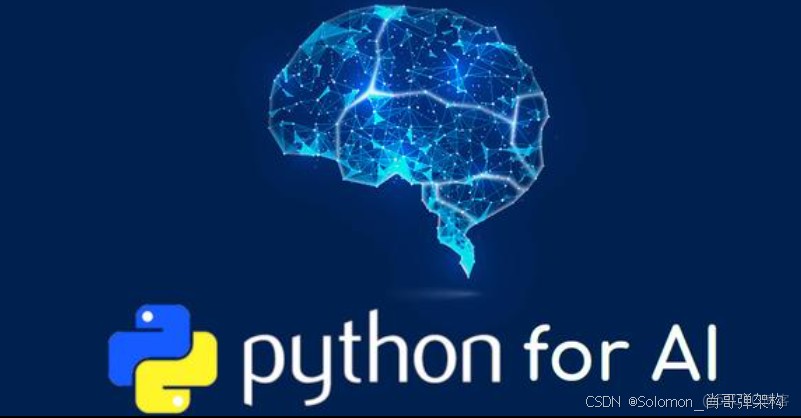python 作为一种功能强大且易于学习的编程语言,在人工智能(ai)领域得到了广泛的应用。从机器学习到深度学习,从自然语言处理到计算机视觉,python 提供了丰富的库和框架,使得开发者能够快速实现各种 ai 应用。本文将通过多个实际案例,展示 python 在人工智能领域的强大功能和应用前景。

案例一:手写数字识别(mnist)
1. 背景介绍
手写数字识别是机器学习领域的经典入门项目,mnist 数据集包含了大量手写数字的图像,每个图像对应一个数字标签。这个项目的目标是训练一个模型,能够准确识别手写数字。
2. 技术实现
使用 python 的 scikit-learn 库,可以轻松实现手写数字识别。以下是实现步骤:
from sklearn.datasets import load_digits
from sklearn.svm import svc
from sklearn.model_selection import gridsearchcv
# 加载数据集
digits = load_digits()
x, y = digits.data, digits.target
# 设置参数网格
param_grid = {'c': [0.1, 1, 10], 'gamma': [0.01, 0.001]}
# 创建 svm 分类器
grid = gridsearchcv(svc(), param_grid, cv=5)
grid.fit(x, y)
# 输出最佳参数和测试集准确率
print(f"最佳参数: {grid.best_params_}")
print(f"测试集准确率: {grid.best_score_:.2%}")
3. 结果展示
通过上述代码,可以得到最佳参数组合和模型的准确率。这个案例展示了如何使用 python 和 scikit-learn 快速实现一个机器学习项目。
案例二:房价预测(回归问题)
1. 背景介绍
房价预测是一个典型的回归问题,目标是根据房屋的各种特征(如面积、房间数量、地理位置等)预测其价格。这个项目可以帮助房地产公司或个人投资者做出更明智的决策。
2. 技术实现
使用 python 的 scikit-learn 库,可以实现房价预测。以下是实现步骤:
from sklearn.datasets import fetch_california_housing
from sklearn.ensemble import gradientboostingregressor
from sklearn.inspection import permutation_importance
import matplotlib.pyplot as plt
# 加载数据集
housing = fetch_california_housing()
x, y = housing.data, housing.target
# 创建梯度提升回归器
model = gradientboostingregressor(n_estimators=200)
model.fit(x, y)
# 特征重要性分析
result = permutation_importance(model, x, y, n_repeats=10)
sorted_idx = result.importances_mean.argsort()
# 可视化特征重要性
plt.barh(housing.feature_names[sorted_idx], result.importances_mean[sorted_idx])
plt.xlabel("permutation importance")
plt.show()
3. 结果展示
通过上述代码,可以得到特征的重要性排序,并通过可视化展示出来。这个案例展示了如何使用 python 和 scikit-learn 进行回归分析和特征重要性分析。
案例三:卷积神经网络图像分类(pytorch 实现)
1. 背景介绍
图像分类是计算机视觉领域的基础任务之一,目标是根据图像的内容将其分类到预定义的类别中。这个项目可以应用于图像识别、安防监控等领域。
2. 技术实现
使用 python 的 pytorch 库,可以实现卷积神经网络(cnn)图像分类。以下是实现步骤:
import torch
import torchvision
from torch import nn, optim
# 定义 cnn 模型
class cnn(nn.module):
def __init__(self):
super().__init__()
self.conv1 = nn.conv2d(3, 16, 3, padding=1)
self.pool = nn.maxpool2d(2, 2)
self.fc1 = nn.linear(16*112*112, 256)
self.fc2 = nn.linear(256, 10)
def forward(self, x):
x = self.pool(torch.relu(self.conv1(x)))
x = x.view(-1, 16*112*112)
x = torch.relu(self.fc1(x))
return self.fc2(x)
# 数据加载
transform = torchvision.transforms.compose([
torchvision.transforms.resize((224, 224)),
torchvision.transforms.totensor()
])
dataset = torchvision.datasets.cifar10(root='./data', train=true, download=true, transform=transform)
# 模型训练
model = cnn()
criterion = nn.crossentropyloss()
optimizer = optim.sgd(model.parameters(), lr=0.001, momentum=0.9)
for epoch in range(10):
for i, (inputs, labels) in enumerate(dataset):
optimizer.zero_grad()
outputs = model(inputs)
loss = criterion(outputs, labels)
loss.backward()
optimizer.step()
print(f"epoch {epoch+1}, loss: {loss.item()}")
3. 结果展示
通过上述代码,可以训练一个 cnn 模型,并输出每个 epoch 的损失值。这个案例展示了如何使用 python 和 pytorch 实现深度学习模型的训练。
案例四:情感分析(hugging face transformers)
1. 背景介绍
情感分析是自然语言处理(nlp)中的一个重要应用,目标是判断文本中的情感倾向(如积极、消极或中性)。这个项目可以应用于社交媒体监控、市场调研等领域。
2. 技术实现
使用 python 的 hugging face transformers 库,可以轻松实现情感分析。以下是实现步骤:
from transformers import pipeline
# 加载情感分析器
classifier = pipeline("sentiment-analysis")
# 输入文本
texts = [
"i'm excited to learn ai with python!",
"this implementation is terribly confusing."
]
# 进行情感分析
results = classifier(texts)
# 输出结果
for result in results:
print(f"文本: {result['label']},置信度: {result['score']:.2f}")
3. 结果展示
通过上述代码,可以得到每个文本的情感标签和置信度。这个案例展示了如何使用 python 和 hugging face transformers 快速实现情感分析。
案例五:文本生成(gpt-2 微调)
1. 背景介绍
文本生成是 nlp 领域的一个重要应用,目标是根据给定的提示生成连贯的文本。这个项目可以应用于聊天机器人、内容创作等领域。
2. 技术实现
使用 python 的 hugging face transformers 库,可以实现文本生成。以下是实现步骤:
from transformers import gpt2lmheadmodel, gpt2tokenizer
# 加载预训练模型和分词器
tokenizer = gpt2tokenizer.from_pretrained("gpt2")
model = gpt2lmheadmodel.from_pretrained("gpt2")
# 输入文本
input_text = "artificial intelligence is"
input_ids = tokenizer.encode(input_text, return_tensors='pt')
# 生成文本
output = model.generate(
input_ids,
max_length=100,
num_return_sequences=3,
temperature=0.7
)
# 输出结果
for i, sample in enumerate(output):
print(f"生成文本 {i+1}: {tokenizer.decode(sample)}")
3. 结果展示
通过上述代码,可以生成多个不同的文本结果。这个案例展示了如何使用 python 和 hugging face transformers 实现文本生成。
案例六:人脸识别系统
1. 背景介绍
人脸识别是计算机视觉领域的一个重要应用,目标是识别图像中的人脸并进行身份验证。这个项目可以应用于安防、支付等领域。
2. 技术实现
使用 python 的 opencv 和 dlib 库,可以实现人脸识别。以下是实现步骤:
import cv2
import dlib
from sklearn.svm import svc
import numpy as np
# 人脸检测
face_detector = cv2.cascadeclassifier(cv2.data.haarcascades + 'haarcascade_frontalface_default.xml')
landmark_predictor = dlib.shape_predictor('shape_predictor_68_face_landmarks.dat')
# 特征提取
def extract_features(image):
gray = cv2.cvtcolor(image, cv2.color_bgr2gray)
faces = face_detector.detectmultiscale(gray, 1.3, 5)
for (x, y, w, h) in faces:
face = gray[y:y+h, x:x+w]
landmarks = landmark_predictor(face, dlib.rectangle(0, 0, w, h))
features = np.array([landmarks.part(i).x for i in range(68)] + [landmarks.part(i).y for i in range(68)])
return features
return none
# 数据采集
images = [...] # 假设已有图像列表
labels = [...] # 假设已有标签列表
features = [extract_features(img) for img in images]
features = np.array([f for f in features if f is not none])
labels = np.array([labels[i] for i in range(len(labels)) if features[i] is not none])
# 模型训练
model = svc(kernel='linear')
model.fit(features, labels)
# 人脸识别
def recognize_face(image):
features = extract_features(image)
if features is not none:
prediction = model.predict([features])
return prediction[0]
return none
# 测试
test_image = cv2.imread('test.jpg')
result = recognize_face(test_image)
print(f'recognized person: {result}')
3. 结果展示
通过上述代码,可以实现人脸识别功能。这个案例展示了如何使用 python 和 opencv、dlib 库实现人脸识别。
八、总结
通过上述多个实际案例,我们可以看到 python 在人工智能领域的广泛应用和强大功能。从机器学习到深度学习,从自然语言处理到计算机视觉,python 提供了丰富的库和框架,使得开发者能够快速实现各种 ai 应用。这些案例不仅展示了 python 的技术优势,也为开发者提供了宝贵的实践经验。
到此这篇关于python在6个人工智能领域的实际应用示例代码的文章就介绍到这了,更多相关python在人工智能领域的应用内容请搜索代码网以前的文章或继续浏览下面的相关文章希望大家以后多多支持代码网!






发表评论